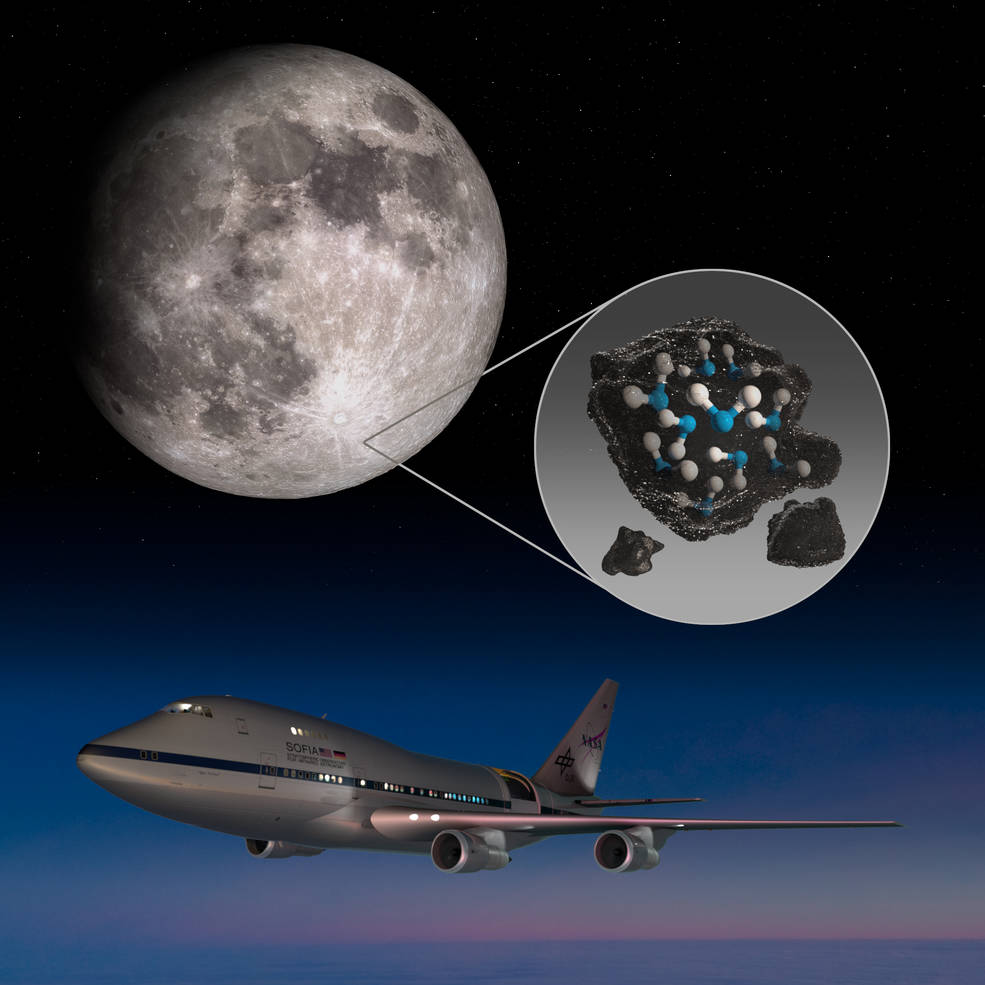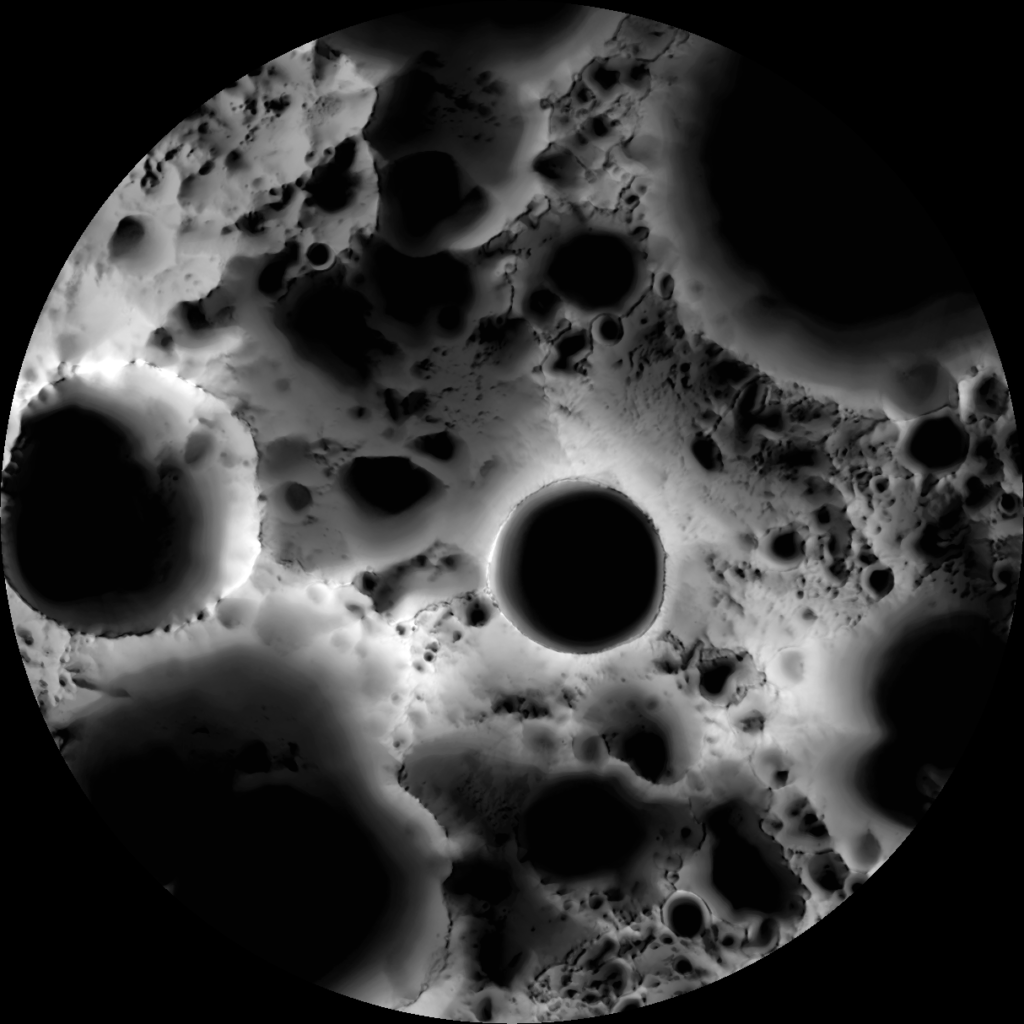Using the Stratospheric Observatory for Infrared Astronomy (SOFIA) NASA researchers have made a stunning discovery regarding the Moon, finding that water is present on the natural satellite’s dayside, as well as its colder nightside. Hydrogen traces had previously been found at the lunar south pole, which experiences near-constant sunlight, but researchers did not believe this was related to water molecules.

At a virtual press conference researchers Paul Hertz, Astrophysics Division director at NASA Headquarters, Washington, Jacob Bleacher, chief exploration scientist for the Human Exploration and Operations Mission Directorate at NASA Headquarters, Casey Honniball, a postdoctoral fellow at NASA’s Goddard Space Flight Center, Greenbelt, Maryland, and Naseem Rangwala, project scientist for the SOFIA mission, NASA’s Ames Research Center, Silicon Valley, California, discussed the findings with journalists from across the globe.
“We had indications that H2O – the familiar water we know – might be present on the sunlit side of the Moon,” says Hertz. “Now we know it is there. This discovery challenges our understanding of the lunar surface and raises intriguing questions about resources relevant for deep space exploration.”
The team’s results could change our fundamental understanding of Earth’s largest natural satellite, and also how water forms and survives in the depths of space.
The findings are significant as previously NASA had believed that water could only be found on the Moon’s nightside and in deep cavernous craters, where it may be hard to reach. Scientists had believed that water of the sunlit side of the Moon would be boiled away as a result of the lack of atmosphere and from constant exposure to the sun.
Casey Honniball offers two possible explanations as to how this water found itself at the lunar south pole; suggesting that it could have been delivered by solar winds, or by micrometeorite impacts.
If the later is the case it could relate to two possible mechanisms. Not only could micrometeorites deliver water to the surface, but the heat from these impacts could also fuse together two hydroxyl molecules, thus creating a water molecule. If this is the case, the water is likely to be sealed within tiny glass beads, about the size of a pencil tip created by the immense heat of impact.
If the water is locked up in these glass beads, they would provide an excellent protective measure to prevent water from being lost to space or evaporating as a result of the Moon’s harsh conditions.
Credits: NASA/Ames Research Center
How Much Water Have NASA Found?
Previous measurements of hydrogen signals from the moon’s sunlit side had been associated with hydroxyl molecules, which at a 3-micron scale at which observations were performed, is indistinguishable from water. SOFIA’s observation was conducted at an improved 6-micron resolution, thus allowing astronomers to confirm the presence of water.
“Prior to the SOFIA observations, we knew there was some kind of hydration,” says Honniball, the lead author who published the results from her graduate thesis work at the University of Hawaii at Mānoa in Honolulu. “But we didn’t know how much, if any, was actually water molecules – like we drink every day – or something more like drain cleaner.
“Water has a distinct chemical fingerprint at 6 microns that hydroxyl does not have.”
Naseem Rangwala points out the amounts of water found, equivalent to roughly a 12oz bottle of water in a cubic meter, is extremely spread out.
Whilst the observations are only of the Moon’s surface, if the water is contained in glass beads then it is expected that these beads could find their way deeper beneath the lunar surface.
SOFIA will now conduct follow-up observations looking for water in additional sunlit locations and during different lunar phases to learn more about how the water is produced, stored, and moved across the Moon.
SOFIA–So Good
SOFIA is the world’s largest airborne observatory, a modified 747 that cruises high in the Earth’s stratosphere. From an altitude of 38,000 — 40,000 feet SOFIA’s onboard 2.7-meter (106-inch) reflecting telescope is able to capture a clear view of the Universe and objects in the solar system in the infrared spectrum, untroubled by the obscuring effect of 99% of the atmosphere’s water vapour. It is this unobscured view that has allowed it to capture data that led to this astounding new discovery about water on the Moon.

SOFIA’s main purpose is to observe the Universe in the infrared spectrum, spotting objects and events that aren’t observable in visible light. The fact that it is mounted aboard a modified 747 means it can make observations from any point on Earth, a feature that has made it particularly useful for spotting transient events. This includes eclipse–like occurrences of Pluto, Titan–a moon of Saturn, and MU69–a Kuiper belt object also known as Arrokoth, which earned the nickname the ‘space snowman’ due to its bowling pin-like shape.
What is astounding about SOFIA’s observation is that it was made during a test of the telescope as the renovated 747 flew over the Nevada Desert on its way back to its home base in California. The telescope itself isn’t usually used to view relatively bright objects such as the Moon. Instead, it would usually be used to observed dim objects such as black holes, star clusters, and distant galaxies.
“It was, in fact, the first time SOFIA has looked at the Moon, and we weren’t even completely sure if we would get reliable data, but questions about the Moon’s water compelled us to try,” says Rangwala, SOFIA’s project scientist at NASA’s Ames Research Center in California’s Silicon Valley. “It’s incredible that this discovery came out of what was essentially a test, and now that we know we can do this, we’re planning more flights to do more observations.”
Water, Water, Everywhere. But is there a drop to drink?
This new discovery contributes to NASA’s efforts to learn about more about the Moon, in the process supporting its goal of deep space exploration. The big question is how accessible is this water and can it be used by a future mission?

Credits: NASA/GSFC/Arizona State University
The researchers are clear that answering many of these remaining questions will require getting down to the surface of the Moon The data collected by SOFIA will be of use to these surface mission, particularly for the future NASA mission Volatiles Investigating Polar Exploration Rover (VIPER). VIPER will take to the surface of the Moon to create a water resource map of its surface, which can then be used by future missions.
“Water is a valuable resource, for both scientific purposes and for use by our explorers,” explains Bleacher. “If we can use the resources at the Moon, then we can carry less water and more equipment to help enable new scientific discoveries.”
If water can be mined from the Moon, it could fulfil a variety of use, including the synthesis of oxygen for astronauts, and even the creation of fuel. Understanding what form the water is in is key to understanding how to extract it.
“Finding water that is easier to reach is important to us,” says Bleacher. “If it is locked up in glass beads it may take more energy to retrieve than if it locked up in the soil.” That means NASA will be looking to discover what state the water is in.
All this comes ahead of NASA’s 2024 Artemis program which will see the first woman and the next man sent to the lunar surface. This will be in preparation for NASA’s next major goal, human exploration of Mars, which could begin as early as the 2030s.
In addition to these practical applications for future space exploration, a deeper understanding of the Moon enables astronomers, cosmologists, and astrophysicists to piece together a better picture of the broader history of the inner solar system and the possibility of water existing deeper in space.
[no_toc]


